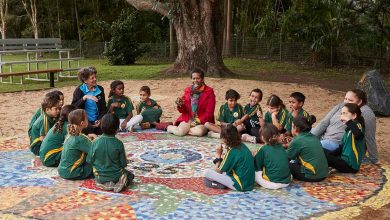
Professor Field Rickards is the Dean of the Melbourne Graduate School of Education (MGSE). He began his career as an audiologist, followed by lecturing in audiology, before applying his clinical approach to education. Lecturers from MGSE appeared in the ABC documentary, Revolution School academic advisors and mentors to the teaching staff of Kambrya College.

The college is a member of the MGSE partnership of schools, which facilitates clinical practice for pre-service teachers, and provides professional support and mentorship to the schools’ teaching staff. The successful series has engaged audiences and propelled the concept of clinical teaching into the public domain.
What is clinical teaching?
In a 2015 Journal of Education for Teaching article titled, ‘Teaching as a clinical profession: translational practices in initial teacher education, an international perspective’, Davies et al. referred to the movement as, “the adaptation of a medical discourse to the preparation of teachers, offering a new paradigm for teacher preparation learning, which has at its centre the ‘translation’ and application of theory and research in the sites of practice”.
Professor Rickards also refers to this concept of ‘a new paradigm of teaching’. He says it’s a system that places the learning process of the student at the centre of operations. Teachers analyse the efficacy of their teaching by looking to the student for evidence. In any other clinical profession, the client is both the focus and the yard stick by which a practitioner’s success is measured. If the client does not benefit from the practitioner’s work, the practitioner must change their input.
“A doctor will take a history, do an examination, do some tests, and come up with a hypothesis of what might be the cause. It might be one of two comparable causes, so there will be a treatment, but if the patient comes back a week later, and hasn’t improved, then we have to test something else,” Professor Rickards’ explained.
“Clinical teaching is evidence based decision making that enables teachers to meet the needs of individual learners. While doctors are “trying to fix problems, teachers are trying to enhance learning,” he concluded.
Clinical teachers ask:
- What does each student know now, and what are they ready to learn next?
- What are the evidence-based practices that can be used in that area in order that student learning progresses from the current stage to the next?
- What teaching strategies should the teacher use to implement those ‘interventions’?
- What has been the impact of the intervention and what should happen next?
During an interview with Maxine McKew on ABC podcast The Conversation, Director of Melbourne Educational Research Institute, Professor John Hattie said, “quite frankly Maxine, I don’t care how you teach, I only care that you have an impact from your teaching”.
This comment appears to indicate that clinical teaching is such an individualised approach to teaching, that it allows for variation in learning styles, and teacher individuality. A teacher can use their own interests or talents to enhance the learning of their students, as long as it works. According to Professor Rickards, “the critical thing is: does the teacher have the capability to evaluate the impact they’ve had on student learning?”.
How can teachers evaluate the impact of their teaching?
An initial assessment must ascertain the starting point, or the building blocks, with which you may construct the program for a student. Students present with a number of factors that will influence how you approach their learning. A student may have arrived in Australia as a refugee and missed years of schooling; be learning impaired; speak an Indigenous language (or several) as their first language/s, or come from a low socioeconomic background. The teachers must have a deep understanding of each student’s individual circumstances and prior learning experiences.
After identifying the starting point, clinical protocol dictates that the practitioner combine their knowledge of the patient with their knowledge of current research, to devise a ‘treatment’ or in the case of teaching, an educational plan. After delivery of each unit of that plan, (which may be as small as ‘a lesson’), the students are assessed to see if they have progressed along their own learning trajectory. However, in order to assess learning outcomes, teachers need to be trained in “what knowledge of subject matter looks like”, and obtain evidence of learning from their students on a week-to-week basis.
Evidence can be defined as, “what the children do, make, say or write”; a phrase attributed to MSGE Professor Patrick Griffin.
While teachers remain aware of target competencies along the curriculum continuum, the idea is not to test all students across lateral benchmarks. “Clinical teaching is about going through an evidence-based decision making process, to ensure that each child has at least a year’s growth in any calendar year,” Professor Rickards clarified. While clinical teaching practitioners ask themselves what the expected competency would be at this stage, their focus remains on stewarding the learner along their own educational path.
While Professor Rickards reassured that clinical teaching does not mean 30 individual lessons, managing these differences does involve tailoring your ‘treatment’ to groups or individuals on a case-by-case basis. Clinical teaching is inextricably linked to the need for the “complex and challenging area” of teaching to be more collaborative. “In no other profession are complex problems dealt with by a team of one,” Professor Rickards remarked. “We need to move away from this culture of one teacher one craft, we want teachers working in teams.”
With some exceptions, mainstream practice still favours the ‘one teacher, one class’ model, leaving little opportunity for individualised education or collaborative support. With considerable variances in student ability, teachers are faced with stretching themselves across ability gaps spanning years of schooling.
Team-teaching allows teachers to support each other, and “stretch the most able students”, while supporting struggling students. “We want our most able teachers to be working with the most challenging children.”
Teaching teams also allow cross-training and mentorship, and “every school needs at least one lead teacher who is an expert at identifying the learning needs of children, and devising programs that will accelerate, and align with learning outcomes,” Rickards recommended.
In a modern school setting, non-teaching staff also engage in supporting students, and as Professor Rickards pointed out, “when teachers are using evidence-based decision making, they are speaking the same language as other professionals working at the schools, like the speech pathologists and the educational psychologists”.
In a 2009 paper, titled ‘Teaching as a Clinical Profession’, which was prepared for the National Comprehensive Center for Teacher Quality, USA, Alter and Coggshall outlined a set of five key characteristics of clinical practice. The characteristics are, centrality of clients, involving direct observation; knowledge domains, practitioners must have specialised skills and expertise; use of evidence and judgment in practice, including knowledge of the individual (through observation and diagnostic tools), as well as knowing what interventions have worked on similar clients; accountability to professional community standards; and finally, rigorous academic and practical training before having access to clients.
While Australian teacher training certainly includes a practical element, it can hardly qualify as ‘clinical practice’ when considered in the context of these criteria. Clinical teaching emphasises the importance of data, theory and research in informing interventionist teacher practice. As Professor John Hattie suggests all teachers ask themselves: “Can you actually measure if you are changing the learning lives of students?”
The clinical teaching approach applies a simply clinical paradigm to answer this question. Aspects of teaching are certainly an art form, but, evidence suggests, there’s also a science to it.







